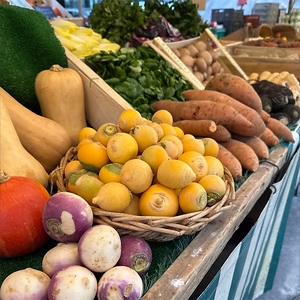


Baby Golden Turnips
Estimated Inventory, bunch : 0
Description/Taste
Baby Gold turnips are small, cruciferous root vegetables that are harvested early to attain their small size. They have a distinct bulbous shape that’s typically wider than it is tall, measuring about 4 to 6 centimeters in diameter. The lower part of the turnip tapers into a tail adorned with fine root hairs. Its light golden yellow skin is smooth, firm, and notably thinner and more tender than that of larger, more mature turnips. At the top, the turnip bulb sprouts three semi-frilled green stems bearing broad, textured leaves. When sliced open, Baby Gold turnips reveal a creamy-white flesh tinged with pale yellow hues that echo the golden tone of their skin. The flesh is fine-grained, moist, and has a crunchy texture similar to a radish. These turnips emit a fresh, earthy aroma with a slight sweetness and mild peppery notes, a contrast to the stronger, sometimes bitter smell of regular sized turnips. Flavor-wise, Baby Gold turnips are sweet, tender, and mild with peppery undertones similar to radishes and subtle notes of rutabaga.
Seasons/Availability
Baby Gold turnips are typically harvested in the cooler months of spring and fall.
Current Facts
Baby Gold turnips, botanically known as Brassica rapa, belong to the Brassicaceae family. This group includes several varieties of Gold turnips, which are marketed under names such as Golden Globe, Golden Ball, and Boule D'or. Classified as cruciferous vegetables, they share this category with cabbage, kale, broccoli, Brussels sprouts, and cauliflower, among other robust produce. While commonly recognized as a root vegetable, the turnip is technically the swollen base of the plant's stem. Ancient turnips more closely resembled carrots rather than the round varieties we see today, a transformation achieved through centuries of selective breeding. Although rutabagas are often mistaken for turnips and are sometimes called Swedish turnips, they belong to a different species. Baby Gold turnips are particularly well-suited for small-space gardening, thriving in window boxes or containers. They remain compact but should not be overcrowded, requiring planting distances of about 7.5 to 10 centimeters apart to ensure proper growth.
Nutritional Value
Baby Gold turnips, like all turnips, are rich in Vitamin C, providing about a third of the daily recommended amount. Vitamin C is crucial for immune function and maintaining healthy skin. Baby Gold turnips are a good source of potassium, which helps regulate blood pressure and muscle function. They also contain fiber, which can alleviate pressure and inflammation in the colon, thus improving digestion. As part of the cruciferous vegetable family, turnips contain several compounds that may have protective effects against certain cancers. For instance, they include sulforaphane, a compound known to potentially interfere with the function of histone deacetylase, an enzyme involved in the progression of cancer cells. In both Ayurveda and Traditional Chinese Medicine, turnips are valued for their ability to enhance digestion, stimulate bowel movements, and aid in detoxification processes.
Applications
Baby Gold turnips can be served raw, simmered, roasted, fried, or pickled. Thanks to their small size, they can be consumed whole or sliced into dishes such as salads with vinaigrette or creamy dressings, and crudités alongside vegetables like carrots, cauliflower, and celery. The flavor of Baby Gold turnips is particularly enhanced when they are braised or sautéed in butter or roasted with thyme. These turnips are excellent when paired with meats, incorporated into purées and soups, mashed as a healthier alternative to potatoes, shredded into coleslaw, or fried to create crispy turnip chips. They also complement a variety of flavors including apples, bacon, cheeses such as Parmesan and Pecorino, chives, cream, chicken, lamb, pork, garlic, lemon, parsley, potatoes, and tarragon. To ensure freshness, always store turnips in a cool, dim area, and remember to wash, trim, and peel them before use.
Ethnic/Cultural Info
Gold turnips are an heirloom variety that has been around for about 150 years, originally known in parts of Europe as Orange or Jelly turnips. During Roman times, turnips were a significant crop, and in the first century BCE, Pliny the Elder, a Roman author and philosopher who wrote "Naturalis Historia"—one of the largest single works to survive from the Roman Empire—highlighted turnips as one of the most important vegetables of his era. The Gold turnip made its way to North America in the mid-1800s. Over the last two millennia, turnips have experienced a dramatic shift in status, transitioning from an ancient favorite to a cover crop, livestock feed, and a staple food for the impoverished. While they are commonly used in Europe and Asia, they remain more obscure in the U.S.
Geography/History
Turnips are native to Europe and Asia, although the exact origins of the Baby Gold turnip remain somewhat unknown. They thrive in temperate climates, benefiting from full sun and partial shade, and are hardy enough to withstand frost. Baby Gold turnips are typically cultivated in gardens and produced commercially, as they are not a wild species but a selectively bred crop. The spread of turnips began before the 15th century and continued as European colonial powers like Britain, France, and Spain transported them to their overseas colonies. The Baby Gold variety, which was developed around 1859, likely gained popularity due to advancements in selective breeding practices during the 19th century. Today, Baby Gold turnips can be found at farmers markets, specialty food stores, and in home gardens.
Recipe Ideas
Recipes that include Baby Golden Turnips. One
| Taste of Home |
|
Turnip Sausage Stew |
| My Recipes |
|
Roasted Radishes and Salad Turnips with Pesto |
| Just a Little Bit of Bacon |
|
Roasted Hakurei Turnips And Radishes |

















